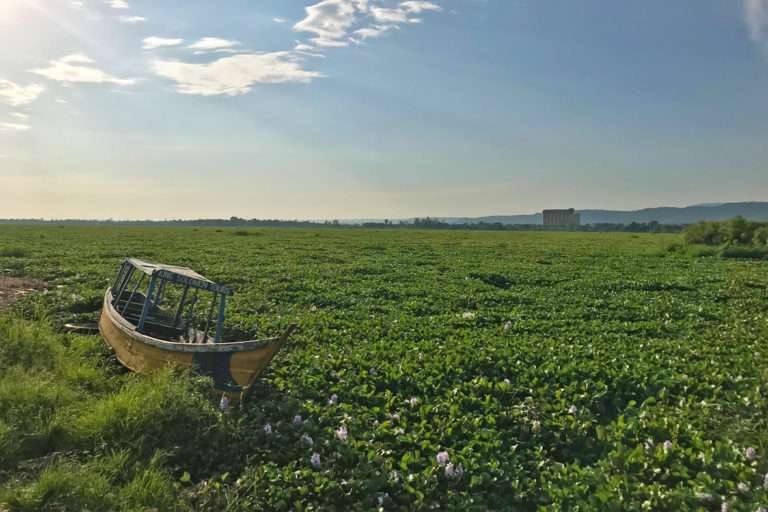Published by Anthony Langat
DUNGA BEACH, Kisumu, Kenya — It’s early morning and fish mongers prepare for the day a short distance from Lake Victoria. Inside a stall, they descale, cut, and clean fresh fish atop rows of concrete tables. Nearly a dozen others, mostly women, set firewood ablaze in simple three-stone firepits and ready blackened pans for a day of deep-frying. Closer to the lakeshore is a restaurant, its ground floor flooded by Victoria’s rising waters — swollen to record levels by months of rain.
On the lake itself floats a blanket of water hyacinth; deep green and shiny — an unwanted and pernicious invasive plant species native to South America with pretty flowers, maybe brought to Africa as a garden pond ornamental that spread to Lake Victoria in the 1980s.
Also near the lake stands a small corrugated tin shack, and beside it a noisy chaff-cutter machine is fed by a young hunched over man. Andrew Chirchir is hard at work in the blazing equatorial heat, crushing water hyacinth into pulp which will then be processed by biogas digesters, producing biofuel used for cooking by economically vulnerable households near Lake Victoria — the world’s largest freshwater tropical lake.
Non-native invasive plants such as water hyacinth have been inflicting havoc on Kenyan livelihoods and ecosystems for years. But the nation is exploring and implementing innovative solutions to reduce the exotic species problem, with the making of biogas, begun at Dunga Beach in 2018, just one of several projects.
The Kenya Plant Health Inspectorate Service reports 32 documented invasive species in the country, including eleven arthropods, ten microorganisms, seven plants (nine according to the U.N. Food and Agriculture Organization, FAO), and four vertebrates. Among the plants are the water hyacinth (Eichhornia crassipes), water fern (Azolla filiculoides), wild garlic (Allium ursinum), prickly pear cactus (Opuntia stricta), Mexican marigold (Tagetes erecta), Spanish flag (Lantana camara), morning glory (Ilpomoea purpurea), and eucalyptus (Myrtaceae genus). FAO deems most of these invaders as having serious impacts on human livelihoods.
A waterborne invasion hurts lake fishery, economy
According to the Kenya Marine and Fisheries Research Institute (KMFRI), water hyacinth in Lake Victoria exhibit a periodic cyclic pattern of disappearance and proliferation, with attendant ecological and economic impacts.
A 2009 study found “declining catchability of fish because of the growing abundance of water hyacinth.” Those low fish harvests lead to lower income for fishermen, and by extension, to reduced incomes along the entire fishery supply chain — hurting everyone from fishing equipment suppliers, to restaurants and supermarkets.
Dr. Christopher Aura, Center Director for KMFRI in Kisumu, and Acting Director for KMFRI Fresh Water Systems, outlined water hyacinth impacts. First off, the plant’s runaway growth and decomposition in Lake Victoria results in serious oxygen depletion contributing to declining fish stocks. The plant “also hinders navigation and movement of boats… entangling fishing gear,” Aura explained.
The dense weed blankets also offer a perfect breeding ground for mosquitoes and other disease-causing insects. People living along bay shores clogged with water hyacinth report higher incidents of skin rash, cough, malaria, encephalitis, gastro-intestinal disorders, and bilharzia/schistosomiasis (an illness caused by parasitic worms). The plant, with its tough roots, also clogs water treatment, irrigation, and water supply systems.
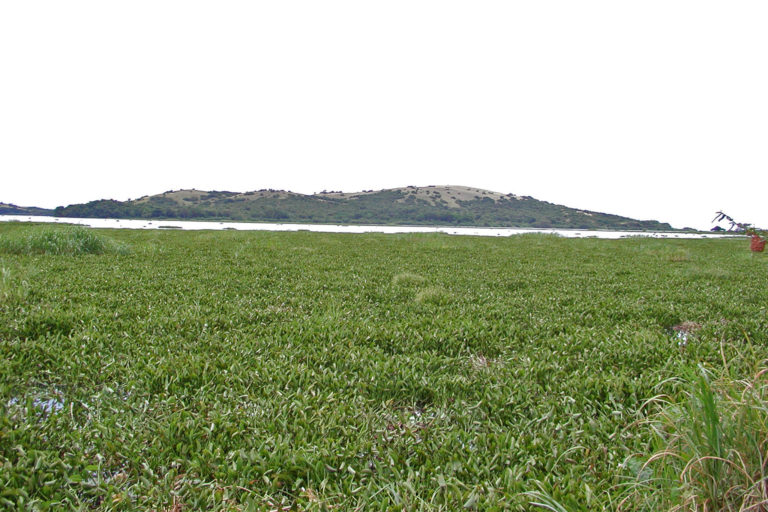
In a bid to control the problem, KMFRI uses satellite data to do projection mapping of the invasive pest. Through geolocation, the institute is able to pinpoint water hyacinth hotspots and share that data with major stakeholders, including beach management units run by fishermen, the county government, captive fish breeders and others.
“With this data, the government, [working] through the National Youth Service and the fishermen too, [can organize] manual removal of water hyacinth. This has been especially effective in Nyakach Bay and Kendu Bay,” said Aura.
The institute has also experimented with the biological removal of hyacinth, using weevils as a biocontrol, but that effort was slow and not successful. Aura says that hyacinth control is difficult due to its fast reproduction, its seeds being able to sit dormant for up to 21 years, and its thriving in a tropical climate.
Learning to live with water hyacinth
Attempts to manually remove the invader can work on a small scale, especially in heavily infested bays, for example, but will never rid the lake of the resilient species. So Kenyans are learning to live with the plant and even utilize it. Since its arrival in-country, the plant, with its tough fibers, has been used in Kisumu to make chair seats, mats and baskets.
One recent idea floated for disposing of the pest: construction of a factory that would utilize hyacinth as a raw material for 3D printing. Investors visited KMFRI to carry out a technical assessment, but the project suffered a setback due to the hyacinth’s periodic pattern of appearance and disappearance in the lake, which would make the business unsustainable.
Maybe a better solution: Dr. Aura proposes scaling up a biogas plant to an industrial level, using water hyacinth as a primary source of raw material, with sewage utilized as a backup during times when plant growth recedes, allowing for the facility’s continuous operation.
Biogas for those in need
At Dunga Beach, Chirchir’s chaff-cutter roars on for close to two hours. By the time he’s done, it’s noon.
He then starts his deliveries to eight households, including those of the elderly, widows, and disabled. Flexi Biogas, the company which started the initiative in Kenya’s Lake Victoria region, has been running a pilot operation there for over a year, serving more than 70 people, especially those in economic need. They receive free maintenance of biodigesters and biofuel stoves and regular refills of crushed hyacinth to their homes.

Chirchir reports to his work station at Dunga Beach each morning, where he begins his day by collecting food waste discarded by local restaurants. He then takes his wheelbarrow to the lakeshore where he loads up on water hyacinth. Three to four wheelbarrow loads are enough to provide sufficient slurry for at least two shipments to the households weekly.
George Oganga lives in Dunga Village, a short distance from the beach. A road accident several years ago injured his spinal cord and legs, leaving him disabled, only able to move about using a crutch. The accident also left him unable to travel and pursue his dry maize business. He now lives with his son and two grandchildren. His disability caused him to be chosen to benefit from the pilot biogas system when Flexi Biogas launched it.
Before the installation of a home biogas stove fueled by water hyacinth, Oganga used charcoal, firewood or paraffin to cook his meals. He preferred paraffin to charcoal because of ease of use, but both produced lots of smoke which wasn’t good for his breathing or health. Charcoal was better but more expensive, costing Kes 3,000 ($30) per month. “Now, with this biogas system, I don’t spend on cooking fuel. They crush it, bring it here and feed it themselves… to the digester twice or three times a week,” he said.

The prickly pear curse
Prickly Pear cactus (Opuntia Stricta), is another invasive plant, introduced on Kenya’s Laikipia North plateau in the 1940’s by a colonial administrator. Local legend has it that the official brought the plant from Mexico and planted it at his government residence in Doldol Town, a semi-arid scenic area with sweeping views and rolling hills. Local Laikipiak Maasai old men supposedly saw the prickly pear and liked its appearance. The administrator offered the plant to them saying it would work well on their homestead compounds, with its thorns useful for keeping out nighttime predators — a mistake.
That was just the beginning of dispersal. Later, livestock and wildlife fed on the fruit and excreted seeds which were dispersed far and wide.
“So that is how this plant spread all over. You can see this at Marupusi Group [Community] Ranch. We will go to Makurian Group Ranch and Ilpolei Group Ranch, where this plant has devastated the ecosystem,” said Francis Merinyi, a resident of Doldol.
By 2006, Doldol residents were feeling the impact of prickly pear. It was estimated that the plant had quickly moved from Doldol’s center to occupy thousands of acres, colonizing rangeland and causing the disappearance of some native grass species.
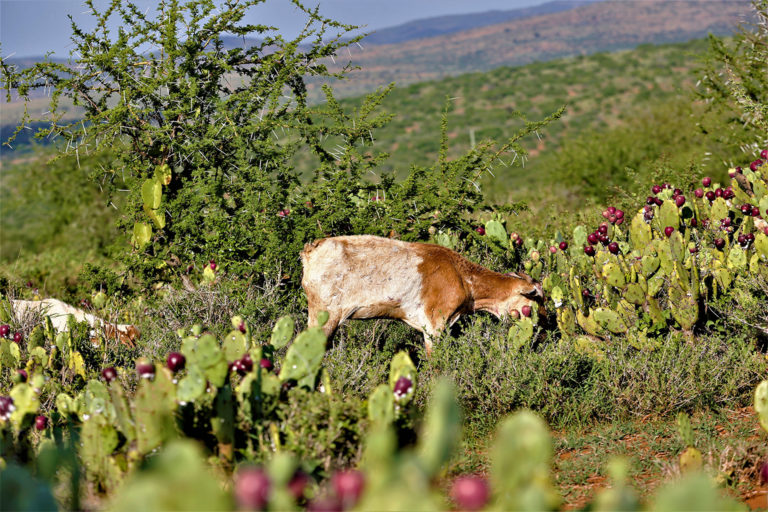
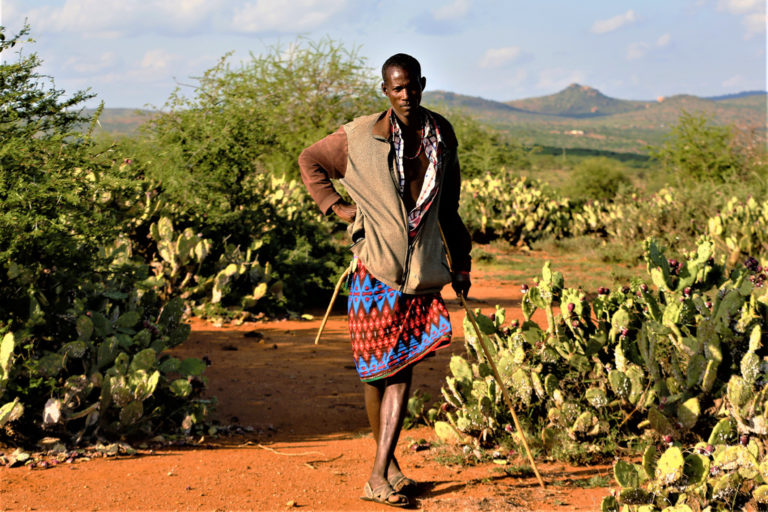
“From Doldol, it has spread towards the west, mostly because of the wind. So, about 10,000 acres have been occupied by the plant,” said Merinyi. This has left livestock and wildlife with no grazing alternative other than prickly pear, despite its injurious thorns.
On a late afternoon, Kamisti Manyas grazed his sheep and goats, moving them homeward to Pisha Village. Of the 170 animals, close to a dozen displayed visible skin injuries. Some looked thoroughly emaciated, despite good pasture following rains in early May. Before the rains, Manyas lost seventy sheep and goats due to injuries sustained from foraging on prickly pear.
The livestock endure the pain in order to get to the juicy fruit. But the more they eat, the more they’re pricked, and the more thorns enter their flesh, mouth and digestive system. “A goat that has a lot of thorns in its system has many wounds which stop it from feeding.… We only hope it can recover so that we can sell it but sometimes they die,” said Manyas.
So painful are the prickly pear wounds that often during drought, wounded livestock can be seen sticking their tongues out for hours. On the way from Merinyi’s home of Kiwanja to Soitaudo, a brown bullock stood by the roadside, its tongue stuck out in pain, a big wound visible on the tip. Merinyi said that he hadn’t seen such a big oral wound before.

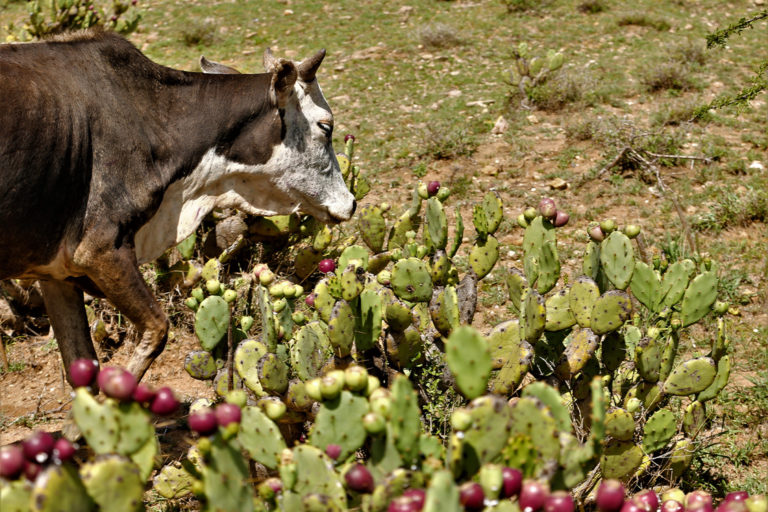
When the thorns get to the digestive system, they lodge there. When the livestock are slaughtered, the intestines, a delicacy among the Maasai, can’t be eaten because of the thorns. People then have to discard the nutritious intestines — a waste. “Even livestock buyers buy our goats at a lower price because the intestines won’t be eaten,” said Manyas.
A prickly pear biocontrol insect shows promise
Much of Doldol is composed of community-owned land, made up of group ranches with individual community members as shareholders. These group ranches are battling the prickly pear.
On the way to Soitaudo, where a women’s group started a biogas plant using prickly pear, elephants graze in groups. Merinyi reported that the many elephants hugely contribute to the spread of prickly pear, as they voraciously eat the plant, defecate and spread the seeds. A 2017 census found 7,347 elephants in the Laikipia-Samburu ecosystem, of which Doldol is a part. While Doldol is surrounded by land conservancies like Ol Jogi and Loisaba, wildlife in Doldol is not confined by fences. Wild animals graze freely, dispersing prickly pear far and wide.
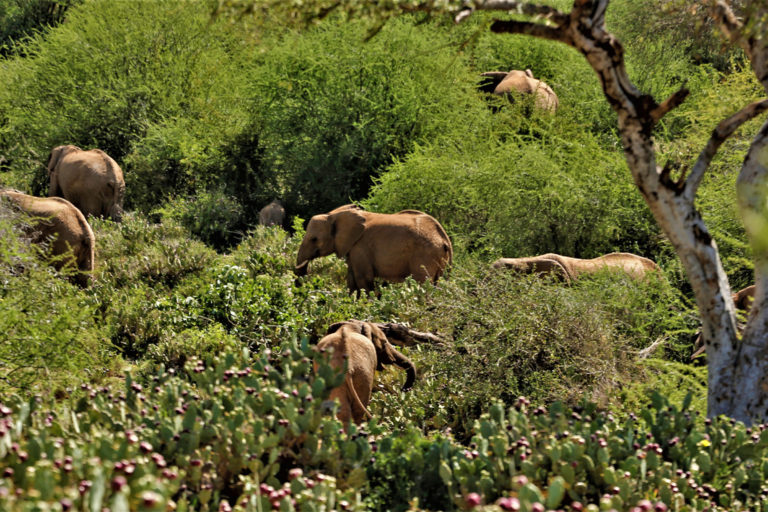
To control the plant’s fast spread, a biocontrol insect, cochineal, was introduced in 2014. Community members grow cochineals in large numbers within greenhouses, and then manually place them on prickly pear plants once every month. The insects feed on the plant and die. While it takes long for the invader to be killed via cochineal infestation, it’s the only biological control introduced so far.
In Munishoi Village, I viewed one of these odd greenhouses. Inside are tin buckets containing prickly pear branches infested with breeding cochineals. Agnes Mamae is one of sixty local women whose job it is to help disperse the cochineals.
“Every tenth day of the month, we take the cochineals to the prickly pear in the rangelands. We ensure to leave at least one branch of the prickly pear in the greenhouse to rear the next swarm of cochineals,” Merinyi said. While he has seen some mitigation progress, the process has been very slow.
Merinyi explained that more greenhouses are needed if the fight against prickly pear is to be won. “After the introduction of the cochineal in the rangelands, we also require [sufficient] propagation to ensure that this is a continuous process. You know these are organisms and we need to rear them in greenhouses and transport them to where the cactus vegetation is. So, we need a lot of support and manpower,” he said.
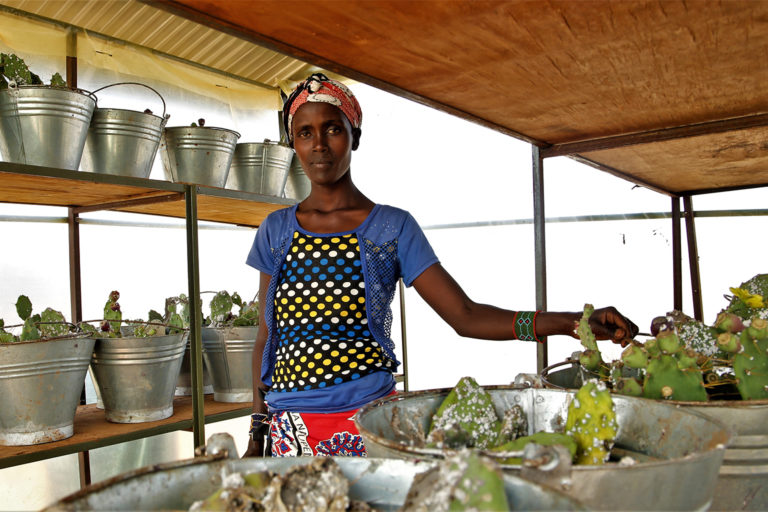

Prickly Pear biogas project
In addition to the insect biocontrol, a group of women from Munishoi are using prickly pear to produce biogas. The Twala Tenebo Cultural Women’s Group brings together more than 200 women near the Ilpolei River and the Ilpolei Center — a conference and meeting facility with cottages, workshop halls and a permaculture project, which hosts travelers, NGOs, government officials and local groups.
Eunice, a women’s group member who runs catering for the facility’s clients, said when she started out, she used LPG gas to cook with, which costs around US $20 per 13 kilograms, which required refills every two week or so.
About two years ago, Eunice and others in the women’s group visited Merinyi’s homestead where he trained them to produce biogas from prickly pear. Merinyi, working with donations from friends, had bought three biogas digesters, along with storage tanks, cooking stoves and a petrol-powered chaff-cutter.

He trialed the innovation at his homestead in Kiwanja, and after that began training people in its use. “We are embracing any mechanism to try and reduce this invasive species in this area,” he said. “One way is the production of biogas. We know that when you cut [prickly pear] and utilize it to produce biogas, eventually, the cactus will get finished.”
Together with the Natuum women’s group and others, Twala Tenebo visited Merinyi for training. The chaff-cutter grinds the whole plant down, which is then mixed with water and cow dung if it’s available. “In the first instance, the gas is fermented for 21 days and that is when the bacteria is acting on the green matter. After that, the gas is produced and there is an output which transports the gas to a storage bag,” he said.
With time, however, he realized that the process was likely too expensive to be sustainable for local people. “The women were using a petrol-powered chaff-cutter and therefore it was very expensive to grind the cactus, making [that approach] untenable,” said Merinyi. What’s needed, he said, is a solar powered chaff-cutter to save costs and reduce emissions.
Little by little, the people of Kenya are hoping to cook their way out of their prickly pear and water hyacinth problem.

Article published by Glenn Scherer
